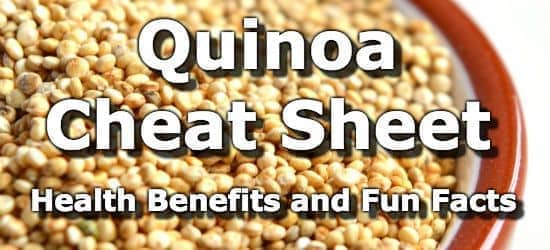Top 5 Health Benefits of Quinoa + Nutrition Info and Fun Facts
Quinoa (Chenopodium quinoa) (pronounced: Keen-Wah) is a small round shaped seed (not grain) which comes in a range of colors from yellow to red. Quinoa is a popular food among vegans as it provides the complete set of essential amino acids.
Quinoa has been popular in South America for over 5000 years but is only now becoming mainstream as people recognize its many health benefits. Quinoa is highly nutritious, gluten free, and has a low glycemic index, making it an ideal staple grain to add to your diet.
Quinoa Health Benefits
1. Quinoa is Highly Nutritious and a Great Source of Protien
Quinoa is so nutritious it has been equated to the nutrient quality of dried whole milk by the Food and Agriculture Organization (FAO) of the United Nations. Quinoa is a great source of manganese, magnesium, phosphorus, fiber, vitamin B9, copper, protein, iron, zinc, and vitamin B1 (1). Quinoa is also rich in phytosterols, phenolics, and betalains which are thought to boost metabolism and reduce cancer risk (2).
2. Quinoa Can Lower Triglycerides and LDL Cholesterol
In one study, subjects were given either 25 grams of corn flakes or 25 grams of quinoa flakes for 4 weeks. The group that ate quinoa flakes saw a significant reduction in triglycerides and LDL cholesterol over the corn group. For the quinoa flake group, average LDL cholesterol levels fell from 129mg/dl to 121mg/dl and triglycerides fell from 112mg/dl to 108mg/dl (3).
3. Quinoa has a Low Glycemic Load
Quinoa has a glycemic index less than 55, making it a low glycemic food. Quinoa is also high in fiber. Studies have shown that a low GI high fiber diet can help with weight loss, and the prevention of type II diabetes (4,4).
4. Quinoa is Gluten Free
Unlike wheat and a variety of other foods, quinoa is gluten free. Studies have shown that quinoa is a good source of vitamins and nutrients for patients with Celiac disease (5). For most people eating gluten does not necessarily carry health risks, however, consumption of gluten has increased worldwide, leading to a growing number of wheat allergies and people with Celiac disease. Alternative grains like quinoa provide a good balance to an otherwise gluten-loaded diet.
5. Quinoa is Lower in Phytic Acid than Other Grains
Phytic acid is a so-called anti-nutrient commonly found in grains that can bind to minerals like iron and calcium, preventing their absorption. Quinoa is superior to other grains since it has a much lower phytic acid level with ranges from 10.5 mg to 13.5 mg, in comparison with corn that contains 720 mg, wheat 390 mg, and rice 60 mg of phytic acid (2).
Quinoa Fun Facts
Quinoa Fun Facts
- Quinoa is actually a seed and not a grain, though it is often considered a grain in the culinary sense.
- The leaves of the quinoa plant can be eaten, like spinach.
- Quinoa means "mother grain" in the Inca language, and has been eaten for 5000 years by the natives who live on the mountain plateaus and in the valleys of Peru, Bolivia, Ecuador, and Chile.
- Quinoa gets its curly appearance when cooked since the germ separates from the seed.
- Quinoa seeds can be black, red, pink, orange, yellow, or white in color.
- When originally grown, quinoa is covered with bitter Saponins. These chemicals evolved naturally in the seeds as protection from birds and insects. Today, most commercial varieties have the saponins already removed, but they can also be removed by soaking the quinoa.
- Mixtures of quinoa and fat created snacks called "War Balls" which nourished Incan armies as they marched over the Andies (6).
- Ashes of quinoa stems are called "lipta". Lipta is mixed with cocoa leaves by Andean farmers as an energy snack (7).
How to Buy Quinoa the Ethical Way
With the growing popularity on quinoa, the price has gone up to the point that many of the people in South America who ate it for years, can no longer afford it. Buy quinoa grown either near your home, or away from Peru, Bolivia, Ecuador, and Chile. This brand on Amazon is grown in California.
Quinoa can also be found in most supermarkets and health stores. Quinoa purchased outside North America needs to have the saponins removed. Saponins are a natural bitter coating found on quinoa. Soak quinoa for 1-2 hours, then change the water, soak again, and rinse. This process will remove the saponins, and their bitterness.
How do I cook Quinoa?
Quinoa can be cooked in much the same way as rice, or even in a rice cooker. Just add 2 parts water for every part quinoa. Be sure to wash and rinse any quinoa you buy, no matter the original or claims otherwise on the packaging. For more information, see our step by step guide on how to cook quinoa with photos.
Data Sources and References
- Quinoa Nutrition Facts
- Quinoa (Chenopodium quinoa Willd), from Nutritional Value to Potential Health Benefits: An Integrative Review
- Metabolic parameters of postmenopausal women after quinoa or corn flakes intake--a prospective and double-blind study.
- Effect of a low-glycemic index or a high-cereal fiber diet on type 2 diabetes: a randomized trial.
- Gastrointestinal effects of eating quinoa (Chenopodium quinoa Willd.) in celiac patients.
- Alternative Field Crops Manual
- Small E. 2013. Quinoa - is the United Nations' featured crop of 2013 bad for biodiversity? Biodiversity 14(3):169-79.
- Martindale W. 1894. Coca and cocaine: Their history, medical and economic uses, and medicinal preparations. 3rd edn. London: H. K. Lewis.
